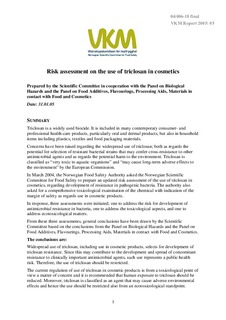Risk assessment on the use of triclosan in cosmetics. Prepared by the Scientific Committee in cooperation with the Panel on Biological Hazards and the Panel on Food Additives, Flavourings, Processing Aids, Materials in contact with Food and Cosmetics
Krogdahl, Åshild; Alexander, Jan; Andersen, Lene Frost; Dybing, Erik; Farstad, Wenche Kristin; Heir, Even; Husøy, Trine; Høiby, Arne; Kapperud, Georg; Kruse, Hilde; Lassen, Jørgen Fredrik; Lie, Øyvind; Lundebye, Anne-Katrine; Lunestad, Bjørn Tore; Løvik, Martinus; Naterstad, Kristine; Narvhus, Judith Ann; Nes, Ingolf; Nesbakken, Truls; Næss, Bjørn; Paulsen, Jan Erik; Rimstad, Espen; Robertson, Lucy Jane; Sanner, Tore; Scheie, Anne Aamdal; Skjerve, Eystein; Skåre, Janneche Utne; Steffensen, Inger-Lise; Sundheim, Leif; Wasteson, Yngvild
Abstract
Triclosan is a widely used biocide. It is included in many contemporary consumer- and professional health-care products, particularly oral and dermal products, but also in household items including plastics, textiles and food packaging materials. Concerns have been raised regarding the widespread use of triclosan; both as regards the potential for selection of resistant bacterial strains that may confer cross-resistance to other antimicrobial agents and as regards the potential harm to the environment. Triclosan is classified as “very toxic to aquatic organisms” and “may cause long-term adverse effects to the environment” by the European Commission. In March 2004, the Norwegian Food Safety Authority asked the Norwegian Scientific Committee for Food Safety to prepare an updated risk assessment of the use of triclosan in cosmetics, regarding development of resistance in pathogenic bacteria. The authority also asked for a comprehensive toxicological examination of the chemical with indication of the margin of safety as regards use in cosmetic products. In response, three assessments were initiated; one to address the risk for development of antimicrobial resistance in bacteria, one to address the toxicological aspects, and one to address ecotoxicological matters. From these three assessments, general conclusions have been drawn by the Scientific Committee based on the conclusions from the Panel on Biological Hazards and the Panel on Food Additives, Flavourings, Processing Aids, Materials in contact with Food and Cosmetics.
